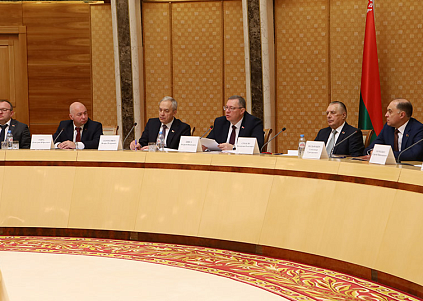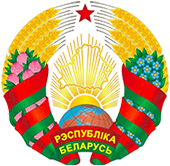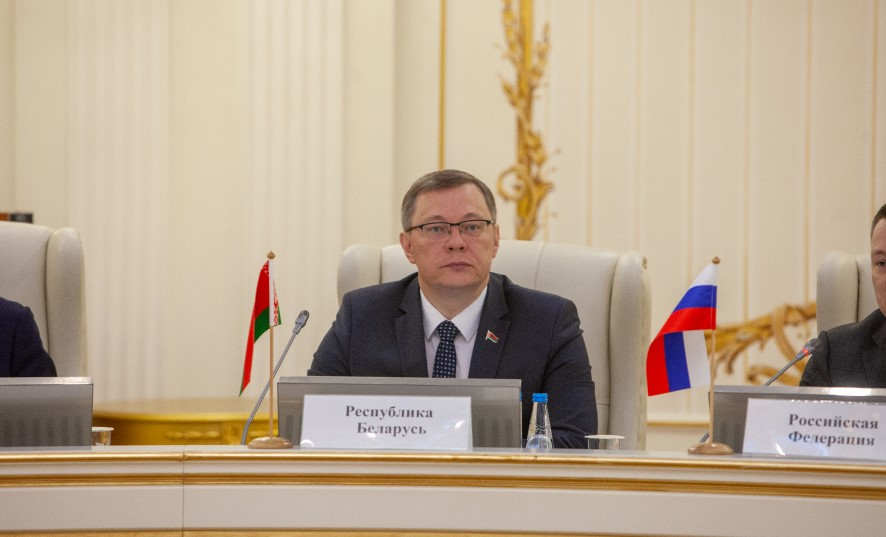Presentation of the Prosecutor General of the Republic of Belarus at the 32nd Meeting of the Coordinating Council of Prosecutors General of the CIS Member States
“Investigation of the criminal case on genocide of the Belarusian people: the restoration of historical memory”
Dear colleagues,
The Republic of Belarus has repeatedly become the scene of the most violent wars. The bloodiest of them was the Great Patriotic War. The Victory has been achieved at the cost of heavy losses including from among the Belarusian people. The remains of millions of people are buried in the Belarusian soil, not only of those who died on the battlefields, but also of those killed in cold blood in the course of genocide of the civilian population.
In April 2021, the Prosecutor General’s Office of the Republic of Belarus initiated and is currently investigating a criminal case on the facts of the commission by Nazi criminals, their accomplices, criminal formations of genocide of the civilian population in the territory of Belarus during the Great Patriotic War and the post-war period.
It can be argued that Belarus was subjected to all forms of genocide provided for by the UN Convention “On the Prevention and Punishment of the Crime of Genocide” (9 December, 1948).
The extermination of the people was massive and was carried out by barbaric methods and means: shootings and hanging, using gas chambers and burning, famishing and epidemic diseases. This was supposed to instill fear, suppress attempts to resist the occupation regime.
Over 260 concentration camps and other places of forced detention of citizens operated in the territory of Belarus where a significant number of people were killed by means of creating unbearable living conditions.
Notorious were such places of mass extermination of the population as the Trostenets death camp (the largest in the entire occupied Soviet territory. According to information available, at least 546 thousand people were killed in it), the Minsk ghetto (at least 90 thousand people killed), the Ozarichi death camp in the Gomel region (several tens of thousands of people killed), the Koldychevo concentration camp in the Brest region (where at least 22 thousand people were exterminated).
The standard scenario adopted by the Nazi war criminals and their accomplices was the destruction of villages along with the inhabitants as part of the so-called “pacification” operations.
During the investigation of the criminal case on genocide of the Belarusian people, numerous previously unknown facts of mass extermination of the civilian population of Belarus by Nazi criminals have been established.
Laborious work is being carried out to record information from eyewitnesses of those events and their relatives. During the preliminary investigation, more than 14 thousand people have been interrogated, of which more than 7.5 thousand were former prisoners of concentration camps.
The investigative group has studied a large amount of archival documents and thousands of criminal cases against Nazi criminals.
More than 400 inspections of incident scenes have been carried out, during which previously unknown places of mass murders of civilians have been identified.
In particular, the analysis of various documents has made it possible to establish that remains of civilians killed by occupiers and their accomplices can be buried in the forest area of the Chenkovskoye forestry of the Gomel region.
In 2021, during the search work in the indicated place, the bones of about five hundred people were discovered and removed. Deaths were caused by gunshots, two shots to the head. Those who did not die immediately were finished off with grenades.
Numerous objects were seized that indicated that it was the civilian population that was exterminated: combs, toothbrushes, plastic buttons, keys, penknives, etc.
The investigation establishes the circumstances of mass burnings of settlements, which were often burned along with their inhabitants. We all know the tragic fate of Khatyn and its residents, but there were thousands of such villages in Belarus.
Interrogations and study of archival documents revealed information about burning of more than 260 villages and other settlements, these facts being previously unknown.
As part of the activities of the interdepartmental commission on perpetuating the memory of the victims of genocide of the Belarusian people created at the initiative of the Prosecutor General’s Office, the burial places are being settled and the remains discovered during the investigation are being reburied.
We have initiated the process of assignment of the special legal status of “historical and memorial burial place” to the places of extermination of the civilian population.
For example, the protective legal status was assigned to the place of mass extermination of the population in the Berezovsky district of the Brest region (Bronnaya Gora).
The evidence obtained during the investigation of the criminal case testifies to the fact that the tragedy of the Belarusian people is much broader than previously thought.
It has been established that during the years of Nazi occupation on the territory of Belarus:
at least 3 million civilians and prisoners of war, or every third inhabitant of Belarus, have been killed;
more than 380 thousand people have been driven into slavery to Germany, many of whom died from unbearable conditions of exploitation. Cases of involving children at forced labor were mass. There have been cases of children being used as blood donors;
over 200 cities have been destroyed, including large ones like Minsk, Gomel, Vitebsk, Polotsk, Orsha, Borisov, Slutsk;
more than 9.5 thousand villages and other settlements have been burned.
Collaborationist formations consisting of nationalists from Latvia, Lithuania and Ukraine, as well as members of the Polish formation “Armia Krajowa” took part in the genocide of the civilian population of Belarus.
Today descendants of some punishers make up the political elites of neighboring States and stand up for a new “Blitzkrieg” in the East.
The 12th Lithuanian battalion only killed more than 10 thousand civilians in the territory of the Minsk region in 1941. The names of some living criminals are known to us, but they are hiding in the territory of some foreign States under their protection. Despite this, we will seek to bring them to criminal responsibility.
To date, we have information on the whereabouts of at least 400 such persons.
During the investigation of the criminal case, the Prosecutor General’s Office sent 60 requests for legal assistance to 18 States, including requests for interrogation of persons who were part of punitive battalions (Lithuania, Latvia, Canada, USA, United Kingdom, Argentina, Brazil, Australia, etc.).
However, requests for legal assistance in the criminal case were ignored by a number of States.
Thus, the Prosecutor General’s Office of the Republic of Latvia refused to execute a request on the grounds of national security of Latvia. We believe that such motivation for refusing to cooperate is far-fetched and cynical in nature.
Along with the investigation, systematic informational, educational and pedagogical work, as well as law-making activities, are being carried out.
Thus, in May 2021, at the initiative of the Prosecutor General’s Office the Law “On Preventing the Rehabilitation of Nazism” was adopted, aimed at preventing all forms and manifestations of Nazism, justifying its doctrine and practice, glorifying Nazi criminals and their accomplices.
Also, at our initiative the Law “On Genocide of the Belarusian People” was developed and adopted in January this year, which provides for the legal recognition of genocide of the Belarusian people and at the same time criminalizes its denial.
The adopted Laws form a legal barrier against attempts to falsify the events and results of the Great Patriotic War.
Article 15 of the new version of the Constitution adopted this year at the republican referendum stipulates that the State ensures the preservation of historical truth and memory of the heroic act of the Belarusian people during the Great Patriotic War.
By decree of the President, the current year in Belarus has been declared the Year of Historical Memory.
The information core of the events to perpetuate the memory of the victims of genocide is formed on the basis of the materials of the criminal case under investigation by the Prosecutor General’s Office:
expositions dedicated to the memory of the victims of genocide, thematic literary sections have been created in museums and libraries of cities and villages;
curricula of educational institutions of all levels are being modified;
an impetus has been given to new scientific, archival research and search work.
Under the editorship of the Prosecutor General’s Office, a collection of information and analytical materials and documents “Genocide of the Belarusian people” was published.
As already noted, the damage caused to the national economy, infrastructure, cultural heritage by the targeted policy of extermination of the people of Belarus is much broader than it has been established during the post-war period by emergency commissions.
During the period of occupation, food, raw materials, industrial products and equipment, as well as museum exhibits, works of art and cultural monuments were withdrawn and sent to Germany.
The interdepartmental working group created at the Government level at the initiative of the Prosecutor General’s Office carries out work to calculate the damage caused during the Great Patriotic War.
The work of the Commission established under the leadership of the Ministry of Culture for the identification, recovery, joint use and introduction into scientific and cultural circulation of cultural values that have ended up outside the Republic of Belarus has been intensified.
It should be noted that the inhabitants of Soviet Belarus massively refused to cooperate with the Nazi regime. Only a few traitors entered the service of the Germans.
White-red-white symbols, images of the “pogonya” began to be used to denote Belarusian nationality among voluntary assistants of the Nazi regime, including among members of armed formations participating in punitive operations.
In 2020, Belarus again faced manifestations of extremism and terrorism under Nazi symbology.
On August 9, 2020, in accordance with the national legislation, the presidential election was held in the Republic of Belarus, in which more than 80 % of citizens cast their votes for the current Head of State A.G. Lukashenko.
However, even before closing of polling stations and summing up the official results of the elections, as well as subsequently, radical-minded individuals made attempts to overthrow the government by illegal means.
Protesters used specially prepared means (stones, sticks, Molotov cocktails) to commit violent acts against officials.
There were cases of intentional hitting-and-running in respect of employees of internal affairs bodies, acts of sabotage, including at railway transport objects, which could lead to numerous casualties and significant damage.
The organizers of the riots used the methods of Nazi Germany, including the collection of information about the personal data of representatives of the Belarusian authorities and administration, their relatives. Persons participating in riots and in commission of other crimes were promised exemption from liability.
As in the years of the Great Patriotic War, “assistance” from abroad became widespread. Suffice is to look where all the leaders of the so-called “protest” are hiding today, from where the information war is being waged against our country.
In fact, what happened was an attempt of a number of Western countries to carry out a coup d’état, to change power in the country by force using extremist elements.
Some of the radical politicized formations in modern Belarus associate themselves with the collaborationist movement during the German occupation. White-red-white symbols were purposefully used during the riots as artificially uniting and identifying.
Why is the topic of the Great Patriotic War and the struggle of the Belarusian people relevant?
First of all, the memory of the sacrifice and deeds of our ancestors is the spiritual basis of our society’s life, an example for us. During the difficult period of the Great Patriotic War, millions of residents of Belarus took an active part in upholding state independence. It was a voluntary patriotic impulse, which reflects the spirit of freedom of the Belarusian people, its willingness to dedicatedly defend national and state interests.
The vast majority of the Belarusian people did not accept the Nazi ideology and the system of the occupation regime, selflessly took part in the most unprecedented struggle against the aggressors in history.
In essence, the people of Belarus was faced with the possibility of termination of its very existence. And the Belarusian people have made their choice.
Unfortunately, in some countries the war crimes of Nazi Germany and its accomplices began to be forgotten.
It is well known where the ideas aimed at the destruction of our State come from. It is in these countries that neo-Nazism is professed, marches of former SS-men are officially held and certain categories of the population are limited in their rights on the grounds of ethnicity. Attempts are being made to justify individual Nazi accomplices by presenting them as alleged “freedom fighters”.
In front of our eyes, monuments to soldiers-liberators are being dismantled in neighboring countries, the graves of Soviet soldiers are desecrated and wreath-laying ceremonies are disrupted, paramilitary organizations openly use Nazi symbols. All this is an attempt to rewrite the history and nullify the feat of the Soviet people.
Today, the facts of committing crimes against peace and security of the mankind are being revealed.
The practice of economic strangulation of peoples in the form of the so-called sanctions policy is again in demand.
As the President of the Republic of Belarus noted, “the medieval struggle for territories and resources continues. Only the crusades were replaced by the expansion of foreign funds... The followers of the Nazis are obsessed with the idea of revenge”.
The investigation of genocide of the Belarusian people during the Great Patriotic War is a tribute to the memory of the deceased and it contributes to the finding out and preservation of historical truth, serves to implement the anti-fascist principle: “Never again!”.
Thank you for attention.
Other news
Main events




